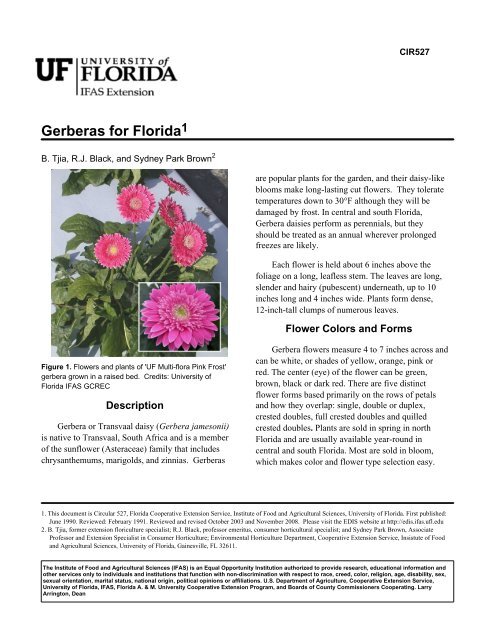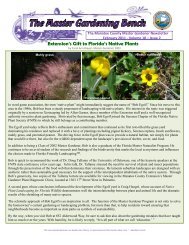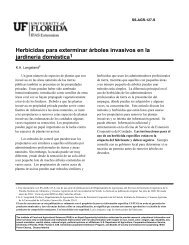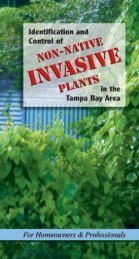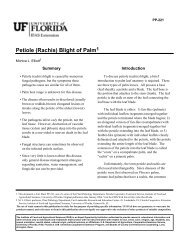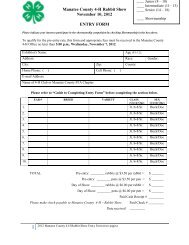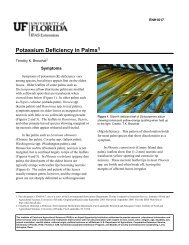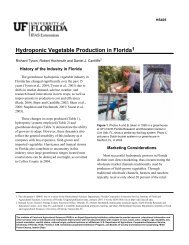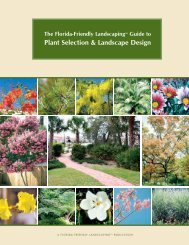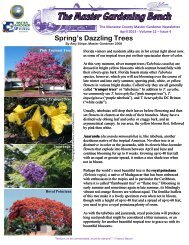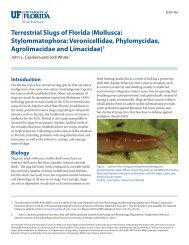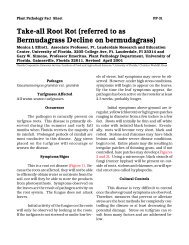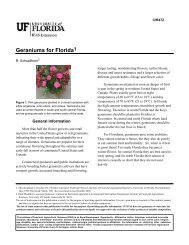Gerberas for Florida - Manatee County Extension Office - University ...
Gerberas for Florida - Manatee County Extension Office - University ...
Gerberas for Florida - Manatee County Extension Office - University ...
You also want an ePaper? Increase the reach of your titles
YUMPU automatically turns print PDFs into web optimized ePapers that Google loves.
CIR527<br />
<strong>Gerberas</strong> <strong>for</strong> <strong>Florida</strong> 1<br />
B. Tjia, R.J. Black, and Sydney Park Brown 2<br />
are popular plants <strong>for</strong> the garden, and their daisy-like<br />
blooms make long-lasting cut flowers. They tolerate<br />
temperatures down to 30°F although they will be<br />
damaged by frost. In central and south <strong>Florida</strong>,<br />
Gerbera daisies per<strong>for</strong>m as perennials, but they<br />
should be treated as an annual wherever prolonged<br />
freezes are likely.<br />
Each flower is held about 6 inches above the<br />
foliage on a long, leafless stem. The leaves are long,<br />
slender and hairy (pubescent) underneath, up to 10<br />
inches long and 4 inches wide. Plants <strong>for</strong>m dense,<br />
12-inch-tall clumps of numerous leaves.<br />
Flower Colors and Forms<br />
Figure 1. Flowers and plants of 'UF Multi-flora Pink Frost'<br />
gerbera grown in a raised bed. Credits: <strong>University</strong> of<br />
<strong>Florida</strong> IFAS GCREC<br />
Description<br />
Gerbera or Transvaal daisy (Gerbera jamesonii)<br />
is native to Transvaal, South Africa and is a member<br />
of the sunflower (Asteraceae) family that includes<br />
chrysanthemums, marigolds, and zinnias. <strong>Gerberas</strong><br />
Gerbera flowers measure 4 to 7 inches across and<br />
can be white, or shades of yellow, orange, pink or<br />
red. The center (eye) of the flower can be green,<br />
brown, black or dark red. There are five distinct<br />
flower <strong>for</strong>ms based primarily on the rows of petals<br />
and how they overlap: single, double or duplex,<br />
crested doubles, full crested doubles and quilled<br />
crested doubles. Plants are sold in spring in north<br />
<strong>Florida</strong> and are usually available year-round in<br />
central and south <strong>Florida</strong>. Most are sold in bloom,<br />
which makes color and flower type selection easy.<br />
1. This document is Circular 527, <strong>Florida</strong> Cooperative <strong>Extension</strong> Service, Institute of Food and Agricultural Sciences, <strong>University</strong> of <strong>Florida</strong>. First published:<br />
June 1990. Reviewed: February 1991. Reviewed and revised October 2003 and November 2008. Please visit the EDIS website at http://edis.ifas.ufl.edu<br />
2. B. Tjia, <strong>for</strong>mer extension floriculture specialist; R.J. Black, professor emeritus, consumer horticultural specialist; and Sydney Park Brown, Associate<br />
Professor and <strong>Extension</strong> Specialist in Consumer Horticulture; Environmental Horticulture Department, Cooperative <strong>Extension</strong> Service, Insistute of Food<br />
and Agricultural Sciences, <strong>University</strong> of <strong>Florida</strong>, Gainesville, FL 32611.<br />
The Institute of Food and Agricultural Sciences (IFAS) is an Equal Opportunity Institution authorized to provide research, educational in<strong>for</strong>mation and<br />
other services only to individuals and institutions that function with non-discrimination with respect to race, creed, color, religion, age, disability, sex,<br />
sexual orientation, marital status, national origin, political opinions or affiliations. U.S. Department of Agriculture, Cooperative <strong>Extension</strong> Service,<br />
<strong>University</strong> of <strong>Florida</strong>, IFAS, <strong>Florida</strong> A. & M. <strong>University</strong> Cooperative <strong>Extension</strong> Program, and Boards of <strong>County</strong> Commissioners Cooperating. Larry<br />
Arrington, Dean
<strong>Gerberas</strong> <strong>for</strong> <strong>Florida</strong> 2<br />
Planting and Care<br />
<strong>Gerberas</strong> grow best in well-drained, sandy soils<br />
amended with organic matter. One to two inches of<br />
peat, compost or other organic material can be<br />
incorporated into the soil be<strong>for</strong>e planting. Excessive<br />
moisture during the rainy season may increase the<br />
incidence of root disease. Where drainage is a<br />
problem, grow gerberas in raised beds, mounds or<br />
containers.<br />
Water the plants well be<strong>for</strong>e you remove them<br />
from the pot. Gently remove the plant from the pot<br />
and examine the roots. Carefully untangle them and<br />
loosen the root ball if they appear “pot bound.”<br />
Space the plants 12 to 18 inches apart, being<br />
careful to plant the crown at or slightly above soil<br />
level. The crown should be visible after watering.<br />
While gerberas like regular moisture, the crown<br />
should be allowed to dry out between irrigations.<br />
Mulch with 1 to 2 inches of organic material, taking<br />
care, once again, not to bury or crowd the crown.<br />
Gerbera crowns gradually sink into the soil after<br />
a period of growth. The crown becomes entirely<br />
submerged after a year or two, and excess moisture at<br />
this time often induces crown rot, causing the plant to<br />
die. To prevent crown rot dig, lift and replant the<br />
gerbera every two years.<br />
<strong>Gerberas</strong> respond to high fertility levels and<br />
should be fertilized regularly. Apply a<br />
controlled-release fertilizer 2-3 times during the<br />
growing season or use a complete fertilizer once a<br />
month. Select a fertilizer that contains iron or<br />
manganese because gerberas are prone to deficiencies<br />
of these micronutrients. You can also correct these<br />
problems with foliar sprays of products containing<br />
micronutrients.<br />
<strong>Gerberas</strong> can be grown in full sun but per<strong>for</strong>m<br />
better with morning sun and afternoon shade.<br />
Remove spent blooms and old leaves regularly to<br />
avoid disease.<br />
Seeds<br />
The most inexpensive way to produce gerberas is<br />
from seed. However, plants propagated from seed<br />
are usually not true-to-type and may vary greatly in<br />
flower color.<br />
Germinate seed in a sterile, lightweight medium<br />
such as vermiculite, perlite or ground sphagnum.<br />
Place the medium in pots or flats that have drainage<br />
holes. Make shallow rows in the medium<br />
approximately twice as deep as the diameter of the<br />
seed. Sow seeds in the rows, cover lightly with extra<br />
medium and water carefully. Cover the container<br />
with a sheet of glass or clear plastic and place the<br />
germination container in bright, indirect light or<br />
approximately 18 inches below a fluorescent light.<br />
Frequently check the soil moisture and do not allow it<br />
to dry out. Transplant seedlings to small pots as soon<br />
as the first true leaves appear. Seedlings can be<br />
grown in small pots until they are large enough to<br />
transplant into flower beds.<br />
Division<br />
<strong>Gerberas</strong> with multiple crowns can be dug and<br />
divided at any time of year in south <strong>Florida</strong> and<br />
during spring and summer in north and central<br />
<strong>Florida</strong>. Separate the crowns using a clean sharp knife<br />
or pruning shears. Remove dead roots, old decaying<br />
leaves and one half of all the lower, mature leaves<br />
and replant immediately. Keep the transplants moist<br />
until they are re-established.<br />
Pests and Diseases<br />
<strong>Gerberas</strong> are often attacked by leaf miner<br />
insects. Tiny flies deposit eggs on the leaves. These<br />
hatch and the larvae feed on the leaf tissue, producing<br />
tunnels that appear as squiggly lines. This is<br />
generally a minor problem. Remove badly damaged<br />
leaves, and if desired, use a systemic insecticide.<br />
Caterpillars and cutworms can also be<br />
destructive. Plants attacked by these pests have<br />
ragged leaves or they may suddenly wilt and die if the<br />
stems have been damaged. Hand picking is the most<br />
effective means of control.<br />
Spider mites and thrips may be problematic.<br />
Both pests feed on plant juices and often go<br />
undetected because of their tiny size. Thrips attack<br />
flowers and leaves; spider mites usually damage new<br />
growth first. Infestations of mites are most severe
<strong>Gerberas</strong> <strong>for</strong> <strong>Florida</strong> 3<br />
during warm dry weather. If a pesticide becomes<br />
necessary, be sure to thoroughly spray the entire plant<br />
including the underside of the leaves.<br />
A number of fungal diseases affect gerberas.<br />
Gray mold is caused by the fungus Botrytis cinerea,<br />
which attacks dead plant parts, and, when conditions<br />
are favorable, spreads to living leaf and flower tissue.<br />
Remove dead or spent flowers and leaves to remove<br />
the source of infection.<br />
Powdery mildew disease (Erysiphe<br />
cichoracearum) occurs during periods of prolonged<br />
cloudy weather and high humidity. Small patches of<br />
white mildew <strong>for</strong>m on leaves and flowers and spread<br />
quickly. Affected plant parts dry up and die. Your<br />
county <strong>Extension</strong> office can recommend effective<br />
products and strategies <strong>for</strong> managing these problems:<br />
http://solutions<strong>for</strong>yourlife.ufl.edu/map/


